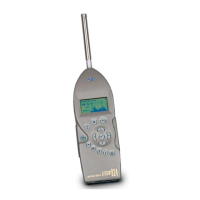9/29/09 Using ID Setting Files 7-39
Intv Threshold - (LOG, SSA) Intv Threshold sets the threshold for computing the interval
time weighted average (TWA). As per the requirements of
various regulatory agencies, only those sound levels which
are above a certain threshold level are used when computing
the TWA. Accordingly, this setting can take on any integral
value within the following range:
0 to 255 dB
For hearing conservation measurements, set the threshold to
80dB. For most community noise measurements, set the
threshold to 0dB.
Intv Exchange - (LOG, SSA) The Intv Exchange sets the exchange rate (sometimes called
the “doubling rate”) that is used to calculate the interval
TWA. The exchange rate reflects the relationship between
the permitted exposure levels and the exposure duration.
Selecting an exchange rate of 5dB, for example, means that
5dB may be added to the permissible exposure level every
time the exposure duration is cut in half. This setting
provides the following four options:
3dB - The 3dB (default) option is the most com-
monly used and results in the L
eq
time weighted aver-
age which is used in Europe and for measurements
that comply with U.S. Environmental Protection
Agency (EPA) regulations.
4dB - The 4dB option results in the L
DOD
time
weighted average which is used for measurements
that comply with U.S. Department of Defense (DOD)
regulations.
5dB - The 5dB option results in the L
OSHA
time
weighted average which is used for measurements
that comply with U.S. Occupational Safety and
Health Administration (OSHA) regulations.
6dB - The 6dB option results in the L
Avg
time
weighted average which is merely a convenient rep-
resentation of the long-term average noise level as
opposed to the RMS noise level.
Intv Spectrum - (SSA only) The Intv Spectrum allows you the choice of storing spectral
data with the interval. It will always give you the Leq

